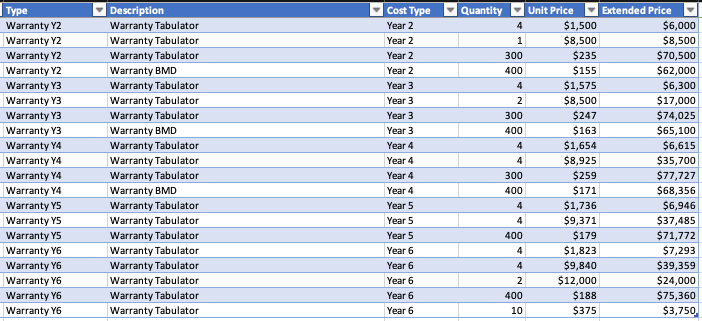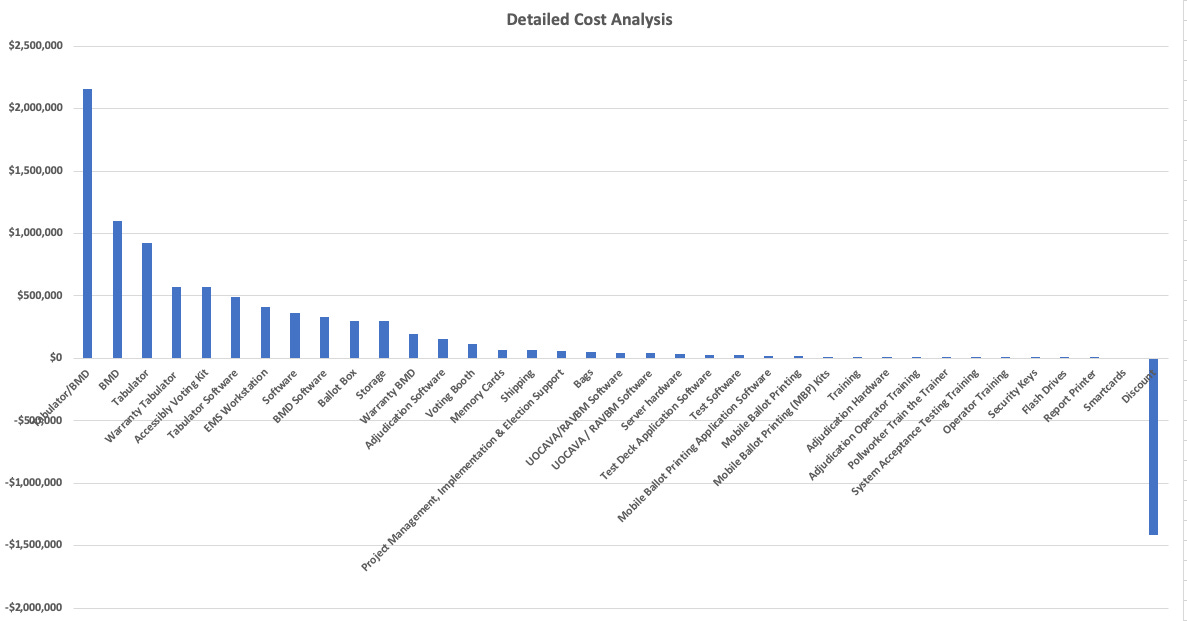This is a summary of a publicly available contract with a county available at lawinsider.com. The name of the county and vendor are omitted as they have little bearing on the actual analysis.
Background
The county in question has ~ 700,000 registered voters as of 2022 and signed a 6 year contract. The contract includes costs for equipment purchase, software license renewal, warranty fees, professional services, storage and other ancillary costs. To put the size of the purchase in perspective, 300 tabulators were acquired along with all of the supporting equipment and licensing fees.
Analysis
For starters, here is the raw data from the purchase contract.
And here is a break down in tabular and graphical form.
This data is what it is, as they say.
Warranty
The part that jumps off of the page to me is the combined warranty costs for the hardware compared to the cost of the hardware.
Hardware costs - $5,869,080
Hardware warranty costs - $763,000
Warranty/Hardware ~ 13% for a 6 year contract.
Then of course there are other questions.
How long do the machines last before they reach end of life?
What happens when they fall out of warranty after 6 years?
If the warranty can be renewed, does the renewed warranty pricing increase substantially?
What work on the machines is excluded from the warranty?
What do the terms of the warranty say about the reliability of the machines themselves?
Cost per Election Cycle
Given that this is a 6 year contract, this equipment will be used 3 times over the six years, excluding, say a special election cycle. This is ~ 2.3MM per election cycle all in for, at most, 700,000 register voters. Given a 60% nominal participation rate, this would amount to ~ $5.50/per ballot/per election cycle.
You could also look at this in terms of the number of days in use as well. Taking a nominal 30 day voting period per cycle, that would mean the system is in use ~ 90 days during the contract period. This amounts to ~ $78,000/day during the election cycle. I have no data on what the insurance costs are on this capital equipment OR if they are on a depreciation schedule.
Conclusion
The decision to not use machines is not only about money. In my mind, we need to transparency and NOT being able to see the machine code prevents 100% transparency.
We need a 100% transparent counting process even, if it is more expensive.
What are your thoughts? Leave them in the comments.











My basic math for hand counting. Say 700k people x 80% turnout = 560k ballots. A bi-partisan team of two could probably count 1,000 ballots easily in 4 hours. 560 teams x 2 people = 1120 people: x 4 hours = 4480 hours; x $15.00 per hour (which is more than election judges were paid) =$67,200. Round it up to $100k. A drop in the bucket compared to the machines. That's one election. 6 year contract... substantially less than $7 million. Probably less than $1 million. Just sayin'...
No more machines, no general mail-in ballots, hand count, one day voting, ID,